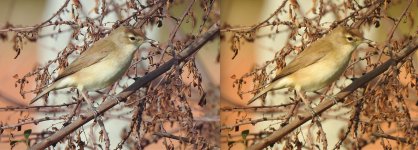Lerxst
Well-known member
All:
Please find images of a bird seen recently just north of Bangalore, India (Dec 2018). Our guide called this a Booted, but I am thinking it is Sykes's. As it was quite busy with the food item, it was not calling, so I have nothing to go on there.
Leg color, forehead shape, extent of supercilium - all this looks consistent with the Sykes's. Hard to see all of the lower mandible, though.
Any comments are greatly appreciated!
Thanks,
Michael
https://legallyblindbirding.files.wordpress.com/2018/12/bootedwarbler1.jpg?w=1280
https://legallyblindbirding.files.wordpress.com/2018/12/war2.jpg?w=1280
https://legallyblindbirding.files.wordpress.com/2018/12/war3.jpg?w=1280
https://legallyblindbirding.files.wordpress.com/2018/12/war4.jpg?w=1280
https://legallyblindbirding.files.wordpress.com/2018/12/war5.jpg?w=1280
https://legallyblindbirding.files.wordpress.com/2018/12/war6.jpg?w=1280
Please find images of a bird seen recently just north of Bangalore, India (Dec 2018). Our guide called this a Booted, but I am thinking it is Sykes's. As it was quite busy with the food item, it was not calling, so I have nothing to go on there.
Leg color, forehead shape, extent of supercilium - all this looks consistent with the Sykes's. Hard to see all of the lower mandible, though.
Any comments are greatly appreciated!
Thanks,
Michael
https://legallyblindbirding.files.wordpress.com/2018/12/bootedwarbler1.jpg?w=1280
https://legallyblindbirding.files.wordpress.com/2018/12/war2.jpg?w=1280
https://legallyblindbirding.files.wordpress.com/2018/12/war3.jpg?w=1280
https://legallyblindbirding.files.wordpress.com/2018/12/war4.jpg?w=1280
https://legallyblindbirding.files.wordpress.com/2018/12/war5.jpg?w=1280
https://legallyblindbirding.files.wordpress.com/2018/12/war6.jpg?w=1280





